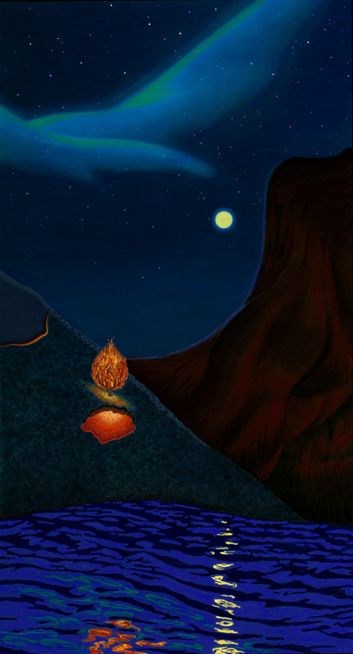

This painting is another cropped section of Eye of Night. It shows the chin, neck and upper chest of the figure with the highlight area of the underarm and upper arm becoming an aurora and the other arm becoming the water. It is a portrait of the four elements. The aurora is air, the smooth, rocky cliff is earth, the lava is fire and water flows below them. A tree of fire (see detail) seems to erupt from the area of visuddha, the throat chakra and through an opening in the lava field we see its roots. I admit this is a very unusual portrayal of the four elements. At first I could not understand what the unconscious meant by it. But as I read von Franz' Aurora Consurgens it began to become a little clearer.
In Aurora Consurgens von Franz comments on the medieval text of the same name. It is an alchemical document on the Old Testament figure of Sapientia Dei or Wisdom. She is a Gnostic figure who is identified with Sophia and contains the dark aspects of the feminine or the spirit in matter. The old text says, "She is a tree of life to them that lay hold on her, and an unfailing light." The fire tree seems to combine the symbol of the tree and the unfailing light (fire). 'Unfailing light' reminds us that she is the 'light of nature', the wisdom in nature, the contents that flow from the unconscious like a spiritual substance. Also, in alchemy, sulphur (here symbolized by lava) represents the light hidden in nature.
In the fifth parable of Aurora, Wisdom builds a treasure-house which can only be opened by four keys, which are the four elements. Inside the treasure-house the sun and moon unite and beget the light of god, the lapis or Philosopher's stone (this seems to have been anticipated in Doppler Effect of the Psyche). Von Franz equates the four elements with Jung's four functions of consciousness. These are: thinking, feeling (understanding the value of a thing), intuition (perception via the unconscious), and sensation (fact-collecting). The stone is the self. She says that the self cannot be realized except by means of all four functions. Otherwise, the whole cannot be perceived. The treasure-house is the space within the psyche where we meet the self and obtain meaning. The process of building the treasure-house is continuous as there is no end to understanding the meaning of the self. It is the process of bringing the self into reality. In the painting, the treasure-house is the human body and this is appropriate because the self can only be known through human effort; it can only be perceived by a person. The self as a light born of the union of the sun and moon emphasizes nature and our need to reconnect to it.
Wisdom is identified with the Logos or the "word of god" and in the painting we see her as the fire tree sprouting up from visuddha, the throat chakra. The human being gives voice to this light of nature. A process is begun by attending to the secret fire, the value inherent in the light of nature. So this painting seems to be about establishing a relationship to the self, a space within the psyche where the self can manifest and bring meaning to one's life, by engaging all four functions and expressing this meaning in the outer world. But it must be remembered that meaning is being expressed through the number archetype of four (elements). Jung tells us that the symbolism of four represents completeness and the relativization of consciousness. In the symbolism of three (e.g. the Trinity) you are tempted to make information from the unconscious an absolute truth. In four you realize that the information is relative and shaped by your reality. Consciousness changes truth; you cannot help but add your point of view. This does not mean total subjectivity, though, because you are basing your viewpoint on inner objective facts, the absolute knowledge available to the unconscious.





